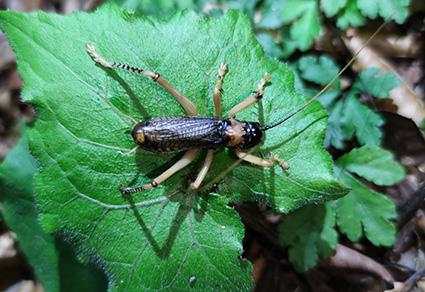Abstract
Based on the specimens deposited in Guangxi Normal University, the paper mainly deals with Capnogryllacris and reports one new species and four new subspecies, viz. Capnogryllacris sequestris Liu, Lu & Bian sp. nov. (Chinese name: 断纹烟蟋螽), Capnogryllacris erythrocephala maculates Liu, Lu & Bian ssp. nov. (Chinese name: 斑背烟蟋螽), Capnogryllacris nigromarginata hainanensis Liu, Lu & Bian ssp. nov. (Chinese name: 海南黑缘烟蟋螽), Capnogryllacris nigromarginata rectispina Liu, Lu & Bian ssp. nov. (Chinese name: 直刺黑缘烟蟋螽) and Capnogryllacris xichou flavifrons Liu, Lu & Bian ssp. nov. (Chinese name: 黄面西畴烟蟋螽). The next-generation sequencing technology was used to sequence the mitochondrial genomes of 13 specimens of Gryllacrididae, and the characteristics of newly obtained mitogenomes were introduced. The gene arrangements are completely consistent with other known orthopteran insects, and there is a long IGS of 166 bp–217 bp between trnK and cox2 genes in three individuals of C. erythrocephala maculatis ssp. nov.. Meanwhile, fourteen specimens of Capnogryllacris were delimited using COI barcode by constructing NJ tree and two distance-based barcoding methods (ABGD and jMOTU). Among the three methods, C. erythrocephala maculatis, C. rufonotata and C. spinosa can be correctly identified, but C. nigromarginata shows some differences in morphological and genetic distance, and Capnogryllacris melanocrania is divided into two clades. The Bayesian inference (BI) and Maximum likelihood (ML) trees based on the 13 protein-coding genes data supported the division of Gryllacrididae into two groups according to whether the male ninth abdominal tergite with median furrow or split along the midline or not.
References
Bernt, M., Donath, A., Jühling, F., Externbrink, F., Florentz, C., Fritzsch, G., Pütz, J., Middendorf, M. & Stadler, P.F. (2013) MITOS: improved de novo metazoan mitochondrial genome annotation. Molecular Phylogenetics and Evolution, 69 (2), 313–319. https://doi.org/10.1016/j.ympev.2012.08.023
Brunner von Wattenwyl, C. (1888) Monographie der Stenopelmatiden und Gryllacriden. Verhandlungen der Kaiserlich-Königlichen Zoologisch-Botanischen Gesellschaft in Wien, 38, 247–394, pls. 5–9.
Cigliano, M.M., Braun, H., Eades, D.C. & Otte, D. (2021) Orthoptera Species File. Version 5.0/5.0. [DB/OL]. Available from: http://Orthoptera.SpeciesFile.org (accessed 10 December 2021)
Cadena-Castañeda, O.J. (2019) A proposal towards classification of the Raspy Crickets (Orthoptera: Stenopelmatoidea: Gryllacrididae) with zoogeographical comments: An initial contribution to the higher classification of the Gryllacridines. Zootaxa, 4605 (1), 1–100. https://doi.org/10.11646/zootaxa.4605.1.1
Dierckxsens, N., Mardulyn, P. & Smits, G. (2017) NOVOPlasty: de novo assembly of organelle genomes from whole genome data. Nucleic Acids Research, 45 (4), e18. https://doi.org/10.1093/nar/gkw955
Gorochov, A.V., Dawwrueng, P. & Artchawakom, T. (2015) Study of Gryllacridinae (Orthoptera: Stenopelmatidae) from Thailand and adjacent countries: the genera Ultragryllacris gen. nov. and Capnogryllacris. Zootaxa, 4021 (4), 565–577. https://doi.org/10.11646/zootaxa.4021.4.6
Gorochov, A.V. (2020) The Families Stenopelmatidae and Anostostomatidae (Orthoptera). 1. Higher Classification, New and Little Known Taxa. Entomological Review, 100 (8), 1106–1151. https://doi.org/10.1134/S0013873820080084
Gu, J., Jiang, B., Wang, H.J., Wei, T., Lin, L.L., Huang, Y. & Huang, J.H. (2020) Phylogeny and species delimitation of the genus Longgenacris and Fruhstorferiola viridifemorata species group (Orthoptera: Acrididae: Melanoplinae) based on molecular evidence. PLoS ONE, 15 (8), e0237882. https://doi.org/10.1371/journal.pone.0237882
Hebert, P.D.N., Cywinska, A., Ball, S.L. & de Waard, J.R. (2003) Biological identifications through DNA barcodes. Proceedings of the Royal Society B, 270 (1512), 313–322. https://doi.org/10.1098/rspb.2002.2218
Huang, J.H., Zhang, A.B., Mao, S.L. & Huang, Y. (2013) DNA barcoding and species boundary delimitation of selected species of Chinese Acridoidea (Orthoptera: Caelifera). PLoS ONE, 8 (12), e82400. https://doi.org/10.1371/journal.pone.0082400
Ingrisch, S. (2018) New taxa and records of Gryllacrididae (Orthoptera, Stenopelmatoidea) from South East Asia and New Guinea with a key to the genera. Zootaxa, 4510 (1), 1–278. https://doi.org/10.11646/zootaxa.4510.1.1
Karny, H.H. (1910) Orthoptera (s. str.). In Schultze, L. Zoologische und anthropologische Ergebnisse einer Forschungsreise i m westlichen und zentralen Südafrika ausgefürhrt in den Jahren 1903–1905. Denkschriften der Medizinisch-Naturwissenschaftlichen Gesellschaft zu Jena, 4, 35–90.
Karny, H.H. (1924) Beiträge zur malayischen Orthopterenfauna VI. Die Gryllacriden des Buitenzorger Museums. Treubia, 5 (1–3), 19–105.
Katoh, K. & Standley, D.M. (2013) MAFFT multiple sequence alignment software version 7: improvements in performance and usability. Molecular Biology and Evolution, 30, 772–780. https://doi.org/10.1093/molbev/mst010
Kumar, S., Stecher, G. & Tamura, K. (2016) MEGA7: Molecular Evolutionary Genetics Analysis version 7.0 for Bigger Datasets. Molecular Biology and Evolution, 33 (3), 1870–1874. https://doi.org/10.1093/molbev/msw054
Li, M.M., Fang, Y., Liu, X.W. & Li, K. (2014) Review of the species of the genus Marthogryllacris (Orthoptera, Gryllacrididae, Gryllacridinae). Zootaxa, 3889 (2), 277–288. https://doi.org/10.11646/zootaxa.3889.2.6
Lanfear, R., Frandsen, P.B., Wright, A.M., Senfeld, T. & Calcott, B. (2017) PartitionFinder 2: new methods for selecting partitioned models of evolution for molecular and morphological phylogenetic analyses. Molecular Biology and Evolution, 34, 772–773. https://doi.org/10.1093/molbev/msw260.
Peng, X., Yang, Z.Z. & Bian, X. (2021) New reports of Capnogryllacris (Orthoptera: Gryllacrididae) from Yunnan, China. Zootaxa, 5047 (3), 391–400. https://doi.org/10.11646/zootaxa.5047.3.10
Vandergast, A.G., Weissman, D.B., Wood, D.A., Rentz, D.C.F., Bazelet, C.S. & Ueshima, N. (2017) Tackling an intractable problem: Can greater taxon sampling help resolve relationships within the Stenopelmatoidea (Orthoptera: Ensifera)? Zootaxa, 4291 (1), 1–33. https://doi.org/10.11646/zootaxa.4291.1.1
Zhang, D., Gao, F., Jakovli´c, I., Zou, H., Zhang, J., Li, W.X. & Wang, G.T. (2020) PhyloSuite: An integrated and scalable desktop platformfor streamlined molecular sequence data management and evolutionary phylogenetics studies. Molecular Ecology Resources, 20, 348–355. https://doi.org/10.1111/1755-0998.13096
Zhou, Z.J., Zhao, L., Liu, N., Guo, H.F., Guan, B., Di, J.X. & Shi, F.M. (2017) Towards a higher-level Ensifera phylogeny inferred from mitogenome sequences. Molecular Phylogenetics and Evolution, 108, 22–33. https://doi.org/10.1016/j.ympev.2017.01.014


